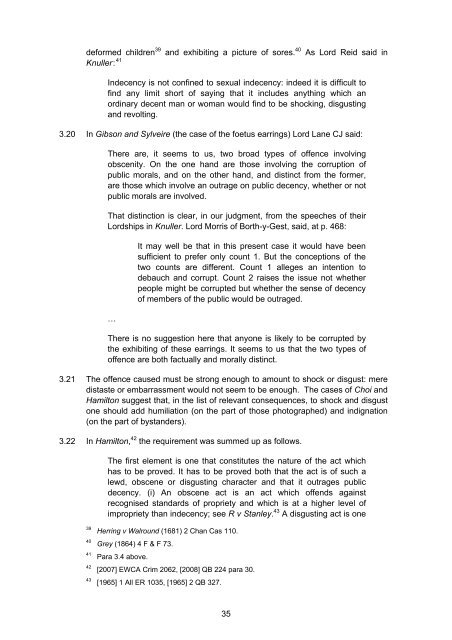public nuisance and outraging public decency - Law Commission
public nuisance and outraging public decency - Law Commission
public nuisance and outraging public decency - Law Commission
You also want an ePaper? Increase the reach of your titles
YUMPU automatically turns print PDFs into web optimized ePapers that Google loves.
deformed children 39 <strong>and</strong> exhibiting a picture of sores. 40 As Lord Reid said in<br />
Knuller: 41<br />
In<strong>decency</strong> is not confined to sexual in<strong>decency</strong>: indeed it is difficult to<br />
find any limit short of saying that it includes anything which an<br />
ordinary decent man or woman would find to be shocking, disgusting<br />
<strong>and</strong> revolting.<br />
3.20 In Gibson <strong>and</strong> Sylveire (the case of the foetus earrings) Lord Lane CJ said:<br />
There are, it seems to us, two broad types of offence involving<br />
obscenity. On the one h<strong>and</strong> are those involving the corruption of<br />
<strong>public</strong> morals, <strong>and</strong> on the other h<strong>and</strong>, <strong>and</strong> distinct from the former,<br />
are those which involve an outrage on <strong>public</strong> <strong>decency</strong>, whether or not<br />
<strong>public</strong> morals are involved.<br />
That distinction is clear, in our judgment, from the speeches of their<br />
Lordships in Knuller. Lord Morris of Borth-y-Gest, said, at p. 468:<br />
…<br />
It may well be that in this present case it would have been<br />
sufficient to prefer only count 1. But the conceptions of the<br />
two counts are different. Count 1 alleges an intention to<br />
debauch <strong>and</strong> corrupt. Count 2 raises the issue not whether<br />
people might be corrupted but whether the sense of <strong>decency</strong><br />
of members of the <strong>public</strong> would be outraged.<br />
There is no suggestion here that anyone is likely to be corrupted by<br />
the exhibiting of these earrings. It seems to us that the two types of<br />
offence are both factually <strong>and</strong> morally distinct.<br />
3.21 The offence caused must be strong enough to amount to shock or disgust: mere<br />
distaste or embarrassment would not seem to be enough. The cases of Choi <strong>and</strong><br />
Hamilton suggest that, in the list of relevant consequences, to shock <strong>and</strong> disgust<br />
one should add humiliation (on the part of those photographed) <strong>and</strong> indignation<br />
(on the part of byst<strong>and</strong>ers).<br />
3.22 In Hamilton, 42 the requirement was summed up as follows.<br />
The first element is one that constitutes the nature of the act which<br />
has to be proved. It has to be proved both that the act is of such a<br />
lewd, obscene or disgusting character <strong>and</strong> that it outrages <strong>public</strong><br />
<strong>decency</strong>. (i) An obscene act is an act which offends against<br />
recognised st<strong>and</strong>ards of propriety <strong>and</strong> which is at a higher level of<br />
impropriety than in<strong>decency</strong>; see R v Stanley. 43 A disgusting act is one<br />
39 Herring v Walround (1681) 2 Chan Cas 110.<br />
40 Grey (1864) 4 F & F 73.<br />
41 Para 3.4 above.<br />
42 [2007] EWCA Crim 2062, [2008] QB 224 para 30.<br />
43 [1965] 1 All ER 1035, [1965] 2 QB 327.<br />
35

















